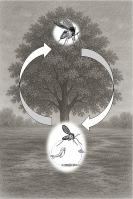反对流动:洪水及其对阿根廷查科地区白蛉生物学的影响
IF 2.5
3区 医学
Q2 PARASITOLOGY
引用次数: 0
摘要
阿根廷的地方性利什曼病呈现多个热点和零星暴发,特别是在潮湿的查科。本研究考察了受洪水影响地区白蛉的生态和行为适应性,重点研究了白蛉的孳生地、垂直分层和季节丰度,重点研究了优势媒介内白蝇。评估了洪水、气候变量和环境变化对疾病风险和控制策略的影响。2011-2014年,在查科市的Puerto Antequeras进行了住所、住所周围和住所外生态系统的抽样调查。2011年9月至2012年12月,每月在地面(1.5 m)和树冠(10 m)设置8个小型cdc诱捕器,并采集土壤样品。2013年1月至2014年12月,采用地面小型cdc和应急诱捕法。气象数据为有关白蛉丰度与气候和生态变量的负二项模型提供了信息。第一期共捕获白蛉28462只,第二期共捕获32009只。内华达占主导地位的,尤指在国外。地表丰富度较高,但冠层动物种类较多。高峰出现在夏季和春季,洪水后丰度增加。最低温度对丰度有正向影响,而河流高度和降水对丰度有负向影响。在第一个时期,土壤样品只产生一种Ny。neivai男性;羽化陷阱在5个陷阱中产生15只个体,主要分布在群落外,在秋季达到高峰。出苗率随最低温度增加而增加,随降水减少而减少。洪水可能会改变繁殖地点,气候变化可能会增加城市传播风险。控制应将病媒监测与生境管理结合起来。本文章由计算机程序翻译,如有差异,请以英文原文为准。

Against the flow: flooding and its impact on phlebotomine bionomics in the Chaco region, Argentina
Tegumentary leishmaniasis in Argentina presents multiple hotspots and sporadic outbreaks, especially in the Humid Chaco. This study examined ecological and behavioral adaptations of phlebotomine sandflies in flood-affected areas, focusing on breeding sites, vertical stratification, and seasonal abundance, with emphasis on the dominant vector Nyssomyia neivai. The influence of flooding, climate variables, and environmental change on disease risk and control strategies was assessed. Sampling was conducted (2011–2014) in Puerto Antequeras, Chaco, across domicile, peridomicile, and extradomicile ecotopes. From September 2011 to December 2012, eight mini-CDC light traps were installed monthly at ground level (1.5 m) and in canopies (10 m), also soil samples were collected. From January 2013 to December 2014, ground-level mini-CDC and emergence traps were used. Meteorological data informed negative binomial models relating sandfly abundance to climatic and ecological variables. A total of 28462 phlebotomines were captured in the first period and 32009 in the second, with Ny. neivai dominant, particularly in the extradomicile. Abundance was greater at ground level, but canopy fauna was more diverse. Peaks occurred in summer and spring, and abundance increased post-flooding. Minimum temperature positively affected abundance, whereas river height and precipitation were negative predictors. In the first period, soil samples produced only one Ny. neivai male; emergence traps produced 15 individuals emerged from five traps, mainly in the extradomicile, peaking in autumn. Emergence increases with minimum temperature and decreases with precipitation. Flooding may shift breeding sites, and climate change could increase urban transmission risk. Control should integrate vector surveillance with habitat management.
求助全文
通过发布文献求助,成功后即可免费获取论文全文。
去求助
来源期刊

Acta tropica
医学-寄生虫学
CiteScore
5.40
自引率
11.10%
发文量
383
审稿时长
37 days
期刊介绍:
Acta Tropica, is an international journal on infectious diseases that covers public health sciences and biomedical research with particular emphasis on topics relevant to human and animal health in the tropics and the subtropics.
 求助内容:
求助内容: 应助结果提醒方式:
应助结果提醒方式:


